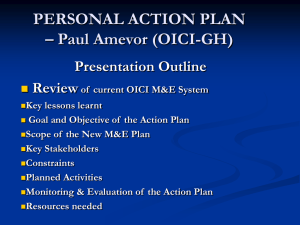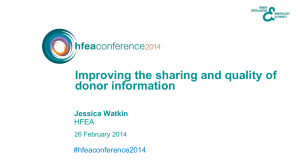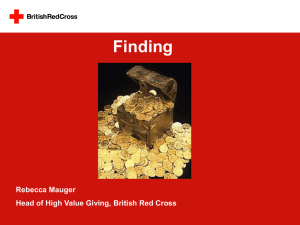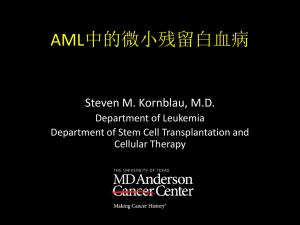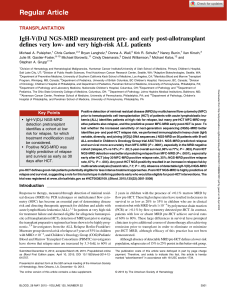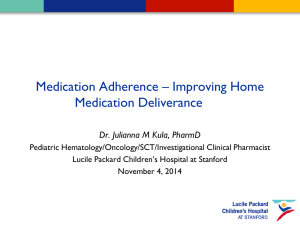Slide 0
advertisement
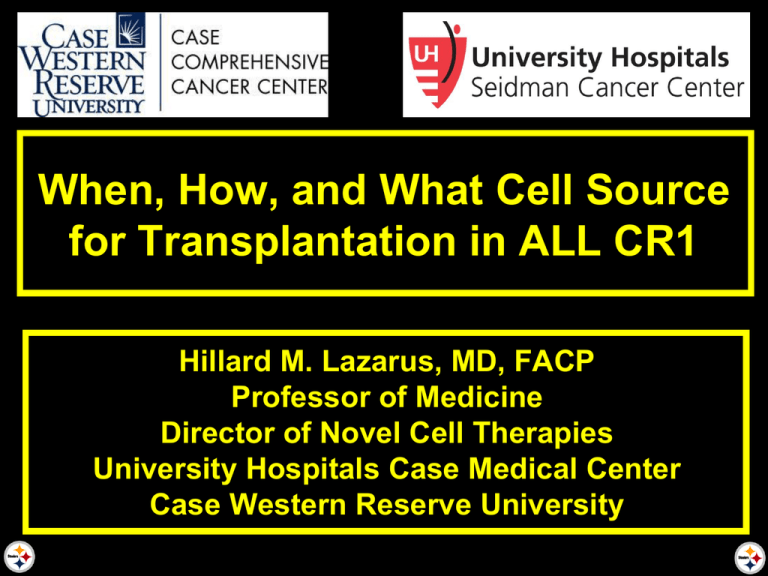
When, How, and What Cell Source for Transplantation in ALL CR1 Hillard M. Lazarus, MD, FACP Professor of Medicine Director of Novel Cell Therapies University Hospitals Case Medical Center Case Western Reserve University ADULT ACUTE LYMPHOBLASTIC LEUKEMIA Definitions In This Presentation Philadelphia chromosome t(9;22)(q34;q11) negative “Adults” = age > 35 years ADULT ACUTE LYMPHOBLASTIC LEUKEMIA Background • Pediatric ALL: 85% cure rate • Adult ALL: Different biology and treatment results • ~ 90% complete remission in age < 60 yr • But despite arduous, long term therapy: • 5-yr survival 30-40% in pts < age 60 yr • 5-yr survival <15% in pts > age 60 yr 7% survival @ 5 years after relapse: few 2nd chances ADULT ACUTE LYMPHOBLASTIC LEUKEMIA MRC UKALL XII / ECOG 2993: N=1,929 INDUCTION HLA donor < 50 (or 55) yr No donor Randomize Assign High-dose methotrexate x 3 Sibling Allograft Autograft Consolidation/ Maintenance JM Rowe, MRC & ECOG. Blood 106: 3760-3767, 2005 AH Goldstone, MRC, ECOG. Blood 111: 1827-1833, 2008. ADULT ACUTE LYMPHOBLASTIC LEUKEMIA Clinical and Laboratory Risk Factors Factors at Presentation Prognosis Association Age Worse with increasing age CNS involvement Slightly worse outcome WBC count at diagnosis Adverse: B cell >30,000/μL; T cell >100,000/μL Immunophenotype B-ALL: Adverse for CD20 and CD25 expression T-ALL: Adverse for CD13; Favorable for CD1a Cytogenetic abnormalities Adverse: t(9;22); t(4;11); t(1;19); complex (>5); low hypodiploid; near tetraploid; BCR-ABL-like Favorable: high hyperdiploid; del 9q Molecular abnormalities Adverse: JAK2; IKFZ1; PAX5; TLX3; BAALC Favorable: TLX1 JM Rowe. Br J Haematol 144: 468-483, 2009. B Oran, DJ Weisdorf. Curr Opin Hematol 18: 395–400, 2011. R Bassan, D Hoelzer. J Clin Oncol 29: 532-543, 2011. J-M Ribera. Curr Opin Oncol 23: 692–699, 2011. ADULT ACUTE LYMPHOBLASTIC LEUKEMIA Clinical and Laboratory Risk Factors (con’t) Factors After Therapy Prognosis Association Time to initial response Adverse: no CR within 4 weeks Minimal residual disease Adverse: detection at various times JM Rowe. Br J Haematol 144: 468-483, 2009. B Oran, DJ Weisdorf. Curr Opin Hematol 18: 395–400, 2011. R Bassan, D Hoelzer. J Clin Oncol 29: 532-543, 2011. J-M Ribera. Curr Opin Oncol 23: 692–699, 2011. ACUTE LYMPHOBLASTIC LEUKEMIA “BCR-ABL-Like” JR Downing, CG Mullighan. Am Soc Hematol Educ Prog 118-22, 508, 2006. ML den Boer, Erasmus. Lancet Oncol 10: 125–134, 2009. PROSPECTIVE POST-REMISSION TRIALS Chemotherapy vs Autograft vs Allograft Design and Outcome ADULT ACUTE LYMPHOBLASTIC LEUKEMIA Autologous Transplant vs Chemotherapy Autotransplants not efficacious (unlike Ph pos ALL) AH Goldstone, MRC, ECOG. Blood 111: 1827-1833, 2008. ADULT ALL POST-REMISSION > 100 Patients/Trial: Age 15-64 Years Group/Year No. Pts PETHEMA 2005 MRCECOG 2008 156 OS: HOVON 2009 JALSG 2011 Disease-Free Survival or Overall Survival Donor No Donor 40% @ 5 yr 1031 High-risk OS: 41% @ 5 yr Standard-risk OS: 62% @ 5 yr 257 DFS: 60% @ 5 yr 649 High-risk OS: 54% @ 10 yr Standard-risk OS: 38% @ 10 yr 49% @ 5 yr 35% @ 5 yr 52% @ 5 yr 42% @ 5 yr 40% @ 10 yr 25% @ 10 yr TRANSPLANT INTENT-TO-TREAT TRIALS Pitfalls Donor vs No Donor Studies • Donor / no donor assigned @ different time points • “Geography” of locating sibs affects search time –If no sib, ? assign to “no donor” @ diagnosis • Older studies: do not address unrelated donors • “Relatively” less-intense induction – CALGB AYA study 10403 • Not all “donor” assignments go to transplant –Physician bias and patient refusal ALTERNATIVE DONORS Graft Source Considerations Time-censoring bias may improves URD outcome: correction required J Mehta. Blood 112: 447-448, 2008 ACUTE LYMPHOBLASTIC LEUKEMIA Leukemia-Free Survival Matched-Related vs Matched-Unrelated Donor N=483 N=189 O Ringden, CIBMTR. Blood 113: 3110-3118, 2009. ALTERNATIVE GRAFT SOURCES IN ALL UCB vs Matched Unrelated Donor: Retrospective Author/ Group No. Pts TRM/NRM Relapse DFS/LFS/OS Eapen: CIBMTR, EBMT 165 UCB 33% @ 2 yr - 44% @ 2 yr 1360 MUD 40% @ 2 yr - 50% @ 2 yr Atsuta: Japan Ferra: GETH, PETHEMA 114 UCB 24% @ 2 yr 31% @ 2 yr 49% @ 2 yr 222 MUD 25% @ 2 yr 24% @ 2 yr 57% @ 2 yr 87 UCB 31% @ 1 yr 29% @ 5 yr 33% @ 5 yr 62 MUD 48% @ 1 yr 29% @ 5 yr 22% @ 5 yr GRAFT SOURCES IN ALL CR1 PhUCB vs Matched Related & Unrelated Donor Overall Survival 95 UCB, ‘CB’ 388 related, ‘RD’ 434 unrelated, ‘URD’ Cumulative incidence relapse S Nishiwaki, Japan Society for HCT. Proc ASCO 2012 (abstract #6533). REDUCED INTENSITY CONDITIONING Relying On “Allogeneic Effect” Evidence For GVL Effect In Adult ALL? Yes PL Weiden, FHCRC. NEJM 300: 1068-1073, 1979 • 163 allografts without GVHD vs 79 allografts with GVHD • Relative relapse rate 2.5 times lower with GVHD (p<0.01) • Anti-leukemia effect more marked in ALL than AML AH Goldstone, UK MRC & ECOG. Blood 111: 1827-1833, 2008 • 239 pts: relapse rate 24% for donor vs 49% no donor (p<0.00005) • High-risk: 37% relapse rate donor vs 63% no donor (p<0.00005) ADULT ACUTE LYMPHOBLASTIC LEUKEMIA Reduced Intensity Conditioning Author/Center No. Pts (CR1) Stein: City of Hope Bachanova: U Minnesota Cho: Korea Nishiwaki: Japan Mohty: EBMTR Marks: CIBMTR Relapse DFS/LFS/OS 24 (11) 21% @ 2 yr 62% @ 2 yr 22 (12) 36% @ 3 yr 50% @ 3 yr 37 (30) 20% @ 3 yr 64% @ 3 yr 26 (21) 26% @ 2 yr 63% @ 2 yr 127 (105) 47% @ 2 yr 32% @ 2 yr 93 (55) 35% @ 3 yr 45% @ 3 yr ACUTE LYMPHOBLASTIC LEUKEMIA PhRIC vs Full-Intensity in CR1/CR2: Survival 100 Survival (%) 75 Full-intensity conditioning (n=1,428) 50 25 Reduced-intensity conditioning (n=93) 0 0 2 4 6 8 Years DI Marks, CIBMTR. Blood 116: 366-374, 2010. 10 E1910 INTERGROUP New diagnosis Ph-, Age 35-70 Yr Remission Induction/Consolidation; start donor search CR Intensification MRD Assessment Randomize (stratify by): Intent: chemotherapy vs HCT after Blinatumumab; MRD status Blinatumomab Bispecific anti-CD3, anti-CD19 antibody No Blinatumomab Chemotherapy ± Blinatumomab versus HCT (optional) MINIMAL RESIDUAL DISEASE Theoretic Time Course Leukemia Proportion leukemic cells Minimal Residual Disease (MRD) Assessment 100 10-1 Complete remission Hematologic relapse Detection limit Morphology 10-2 MRD persistence 10-3 MRD relapse 10-4 Lower limit MRD assay 10-5 Sensitivity limit MRD assay Complete MRD response MRD-based remission assessment M Brüggemann, et al. Blood 2012 MINIMAL RESIDUAL DISEASE Methodologies • Detection sensitivity at least 1:10,000 cells • Molecular • Clonal rearrangements of T cell Receptor (TCR) genes • Clonal rearrangement immunoglobulin (Ig) genes • Flow cytometry • Leukemia-associated phenotye (flow) • FUTURE: high-throughput sequencing universally amplifies antigen-receptor gene segments: more sensitive; use E1910 M Faham, D Campagna, et al. Blood 2012 ADULT ACUTE LYMPHOBLASTIC LEUKEMIA Better Outcome MRDneg vs MRDpos Patients MRDneg patients = < 10-4 via PCR @ wk 16 & totally undetectable @ wk 22; all other patients classified MRDpos R Bassan, Northern Italy Leukemia Group. Blood 113: 4153-4162, 2009 MINIMAL RESIDUAL DISEASE: ALL Kiel MRD Conference Technique PCR Ig genes & TCR genes Advantage Disadvantage high sensitivity time-consuming highly standardized requires extensive knowledge/experience stability of DNA expensive Multiparameter quantitative flow cytometry rapid low cellularity requires extensive knowledge/experience applicable most pt less sensitive 3-4 color (most now use 6 color) M Brüggemann, Kiel MRD Conference. Leukemia 24: 521-535, 2010 M Brüggemann, et al. Blood 2012 MINIMAL RESIDUAL DISEASE: ALL MRD Positive Patients MRD pos @ 16 & 22 wk correlated with 10 wk R Bassan, Northern Italian Leukemia Group. Blood 113: 4153-4162, 2009 MINIMAL RESIDUAL DISEASE Unresolved Issues • Greater use in Europe; need to penetrate USA & other areas • Time to perform assay; real-time availability • Determine optimal methodologies • Standardization of methodologies and definitions • Ensure comparability • Which time points to assay? • Increased cost; who will pay? • Effect of change in therapy? • Transplant (positive) vs no transplant (negative) SUMMARY Factors to Consider For Transplant ALL CR1 PATIENTS AGE 35-70 YR Likelihood To Recommend Transplant Variable Favor Transplant Does Not Favor Transplant Clinical & laboratory risk high-risk standard-risk Induction & consolidation “adult” regimen “pediatric” regimen Sibling-matched donor available none available Minimal residual disease (MRD): result @ 12-16 weeks positive negative ALL CR1 PATIENTS AGE 35-70 YR Factors Affecting Transplant Conditioning Variable Favor Myeloablative Conditioning Favor Reduced-Intensity Conditioning Age 35-55 years 56-70 years Comorbidities absent present ALL CR1 PATIENTS AGE 35-70 YR Factors Affecting Graft Source Variable Favor MUD Favor UCB Institutional experience 8/8 alleleic graft, especially marrow (rather than blood) “Center of Excellence”, extensive UCB experience ALL CR1 PATIENTS AGE 35-70 YR Recommendations and *Paradox • Age <35 yr, enroll on “peds intensity” regimen: • ? whether abrogates need for transplant • ? age at which regimen not tolerated by adults • Age 35-45 yr – gray area, assess risk factors • strongly consider hematopoietic cell transplant • Age > 45 yr – consider transplant, possibly RIC Given greater use of more intensive induction & consolidation therapy in younger patients: *potentially more transplants in older patients *Anthony H. Goldstone, MD

